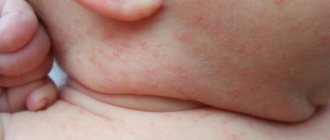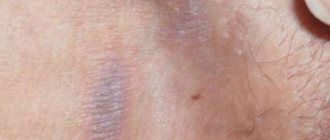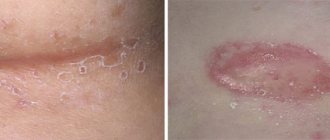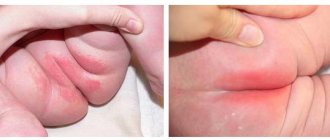Causes of diaper rash
As follows from the very definition of “diaper rash,” the cause of this disease lies in skin irritation from various infections. The folds of the skin, where it is always warm and humid, create ideal conditions for the growth of bacteria. The bacteria themselves enter the skin along with sweat and oily skin secretions. Urine, discharge from fistulas and hemorrhoidal cones, when they come into contact with healthy skin, begin to actively multiply, and we observe a picture of redness, peeling, and erosion of the skin surface. In hot weather, diaper rash occurs more often than usual. Obese people with a large number of fat folds are especially susceptible to this disease. In infants, diaper rash occurs due to lack of proper care and hygiene. It happens that diaper rash occurs due to an allergic reaction to some food or cosmetic product. To accurately identify the cause of allergic diaper rash, an examination by specialists will be required.
Diagnostics: how to distinguish diaper rash from other diseases
The main diagnostic method is a routine visual examination of the patient. If it is a child, then it is examined by a pediatrician in the hospital. Diaper rash in adults is treated by a dermatologist.
If an advanced stage has been identified, which is accompanied by certain complications, the doctor may prescribe tests in the form of culture or scraping. The third degree of diaper rash can easily be confused with other diseases, especially in children. It could be dermatitis or a fungal infection. Therefore, it is necessary to know how to distinguish inflammation from other diseases.
For diaper rash:
- Inflammation appears in the folds of the skin or where it comes into contact with clothing or diapers. If this is an allergy, then it can manifest itself in other areas - face, chest, stomach, back;
- The initial stage is characterized by slight redness, which quickly disappears with proper care. In more severe diseases, redness will not go away without special treatment with ointments or medications;
- The area on the skin affected by diaper rash does not have clearly defined boundaries. In infectious diseases they may look different. For example, if it is lichen, then the affected area will have clear and prominent contours, which are characterized by lighter areas in the center;
- Diaper rash of the first or second stage does not bleed and does not have the characteristic nodules and rash that appears with allergic dermatitis.
- Inflammations without complications of microbial eczema occur without an increase in body temperature, unlike infant roseola and rubella, with which they can be confused.
You need to be as careful as possible about your health and the health of your loved ones. Therefore, if any symptoms of the disease appear, even the most minor ones, it is better to go to the clinic for diagnosis by a professional specialist. It is not recommended to engage in self-diagnosis and self-medication, as you can only aggravate the situation or waste precious time that should be spent on proper treatment of diaper rash.
Symptoms
They are accompanied by redness of the skin, severe itching, and pain. Most often they are found in the groin, on the buttocks, in the lower abdomen, in the armpits, in any folds of our skin.
There are three degrees of the disease:
Lung
It is characterized by slight redness, while the skin is not damaged, there is only a slight swelling.
Average
Here, along with severe redness, obvious mechanical damage is visible on the skin.
Heavy
Greater degree of skin damage, bright red color, formation of ulcers. The primary manifestation of diaper rash always begins with redness of areas of the skin - erythema, which gradually spreads to healthy areas. In severe forms, diaper rash is accompanied by infections. Streptococci and fungi are the most common of them.
Bedsores
Bedsores are formed as a result of constant compression of soft tissues. Simply put, when a person lies in one position for a long time, some parts of the body are constantly compressed. Blood circulation and nutrition are disrupted, soft tissues begin to slowly die. This is called soft tissue necrosis.
Important The process of bedsore formation “starts” after just two hours of body immobility!
Bedsores are characterized by a change in skin color with clear boundaries, swelling, and weeping wounds. If they are not treated promptly, the volume and depth of the lesions rapidly increase. Most often, bedsores occur on the heels, knees, elbows, tailbone, and buttocks. It depends on what position the person predominantly lies in.
There are 4 stages of development of bedsores .
Stage 1. Fading redness
What does it look like:
A pale area of skin or, conversely, persistent redness. The skin is not damaged. If you press your finger into the center of the redness area, the skin will turn pale. This suggests that microcirculation is not impaired.
Stage 1 bedsore on the back. Photo: CPP
Stage 1 bedsore. Photo: ECDO Center
To be sick, but to smile is the norm. Alexey Vasikov, director of the Blacksmith Lobov House of Mercy, about what “norm” means for a seriously ill person and why it sometimes surprises us
Alexey Vasikov
About palliative care
How to treat
It is important to prevent the process of bedsore formation from developing further. Make sure that the person does not lie on the injured area, use protective film breathable bandages (like a “second skin”).
By the way, in this article we describe in detail what types of dressings there are and in what cases what to use.
You can lightly massage healthy skin around the redness area - stroke it clockwise. It is permissible to use activating agents for massage. They improve blood microcirculation in tissues, which leads to improved metabolic processes in tissues, and therefore to an improvement in their condition and increased resistance to negative factors.
These products include special creams and gels with camphor or guarana. But remember, under no circumstances should you use camphor alcohol.
and similar means.
This article will help you understand the variety of foams, dry shampoos, creams and lotions for hygiene, including in special cases - bedsores, stoma, urinary and fecal incontinence.
Stage 2. Non-fading redness
What it looks like: Skin color - bluish-red, spots with clear edges; skin with superficial damage - abrasions, blisters. Usually already accompanied by pain.
Stage 1 bedsore. Photo: Palliative Care Center, Moscow
Stage 2 bedsore. Photo: Palliative Care Center, Moscow
How to deal with unpleasant odors in the home of a seriously ill person Why do unpleasant odors form, is there a specific “smell of old age” and how to deal with this problem
Kristina Osotova
Care
How to treat
It is necessary to prevent the wound from becoming infected. It should be rinsed with sterile saline at room temperature, and then a transparent semi-permeable film, hydrocolloid or foam dressing should be applied. To prevent the formation of bedsores from developing further, follow all anti-bedsore procedures.
Stage 3. Damage to the skin up to the muscle layer or with penetration into the muscles
What it looks like: The edges of the wound are well demarcated, surrounded by swelling and redness; the inside of the wound may be yellow or red. This is necrosis (tissue death) or granulation (tissue growth around). There may be liquid discharge. Hurts a lot.
Stage 2 bedsore. Photo: Palliative Care Center, Moscow
Stage 3 bedsore. Photo: Palliative Care Center, Moscow
Video: Treatment of deep bedsoresWhat to do and how to care if a person has deep bedsores and you do not have the opportunity to see a doctor
Irina ProkopenkoCaring workshop
Care
How to treat
Stage 3 bedsores should only be treated by a doctor. It will cleanse the wound of exudate (liquid that is released from small blood vessels during inflammation) and pus. He will remove necrotic (dead) tissue surgically or dissolve necrosis using special gel dressings, and wash the wounds with saline solution. For secondary infection and purulent discharge, he will prescribe antibacterial agents (for example, metronidazole).
It is important to ensure the absorption of discharge and protect the wound from drying out and infection. For this, atraumatic bactericidal and absorbent dressings are used: based on beeswax with bactericidal properties, hydrogel, based on calcium alginate. They may also have a hemostatic effect.
After cleansing the wound, you need to stimulate its healing process. And, of course, continue all necessary anti-bedsore procedures.
Stage 4. Damage to all soft tissues, tendons and bones visible
What it looks like : Many holes are formed that can connect. The bottom of the wound often fills with black or black-brown masses of decaying tissue. Very strong, unbearable pain.
Stage 4 bedsore. Photo: Palliative Care Center, Moscow
Last stage bedsore, tissue necrosis. Photo: ECDO Center
How to treat
Such bedsores can also only be treated by a doctor. It does the same thing as stage 3 pressure ulcers, plus adds prophylaxis and bleeding control if necessary. For this purpose, atraumatic dressings are used and locally - a solution of ethamsylate and aminocaproic acid, calcium alginate.
Important Sometimes bedsores form in very unexpected places - for example, on the head. Read about this in the article “Bedsores on the head: prevention and treatment.”
Bedsores. Test for those caring for seriously ill people Do you know enough about caring for a sedentary person? Test your knowledge. Caring workshop
Symptomatic treatment
Treatment
In the initial stage of the disease, it is enough to remove the causes of its appearance. It is necessary to frequently and thoroughly wash all folds of the skin with warm water, a pink solution of potassium permanganate, and special antiseptic agents. After washing, be sure to thoroughly blot with a cotton cloth until completely dry, powder with talcum powder or use baby cream, zinc ointment, or any drying creams and ointments. It is necessary to ensure free access of air to the sore areas; if necessary, gauze pads can be attached to them. For moderate severity of diaper rash, lotions and compresses are effective. Therapeutic baths based on medicinal herbs are very helpful in the fight against diaper rash. In addition to the purely therapeutic effect, they provide an opportunity to rest and relax, and have a beneficial effect on the human body as a whole.
What ointment to use for diaper rash under the mammary glands?
When treating diaper rash under the mammary glands, a number of ointments are used, each of which is used in special cases. Before applying the drugs, it is recommended to treat the skin with antiseptics: a solution of potassium permanganate, chlorophyllipt or furacillin.
Warning! This photo contains information not intended for viewing by persons under the age of 18!
If there is swelling in the folds of the breasts and exudate appears, then drying ointments are used: linin, Teymurov ointment, Lassar paste. They contain zinc, antiseptic and anti-inflammatory components, which, along with drying, also have an additional therapeutic effect. They are used mainly at the beginning of therapy.
In the presence of infected ulcers, erosions and cracks, local ointments with antibiotics are prescribed: Levomekol, Clotrimazole, Lorinden S, Sintomycin and others. Their use is more effective when alternating with drying drugs. The use of antibacterial ointments should be limited in time: after signs of infection disappear, their use can be stopped.
After eliminating active exudative manifestations and infection, skin treatment with ointments with a regenerative effect is prescribed: tar paste, panthenol, methyluracil ointment, bepanthen and others. Their use is combined with ongoing hygienic procedures, which are carried out until the signs of the disease completely disappear.
At the final stage of treatment, the skin under the mammary glands can be smeared with baby diaper rash cream or regenerating ointment for 1-2 weeks. This helps the skin restore its protective functions and eliminate the likelihood of relapse of the disease in the short term.
Treatment of diaper rash with folk remedies is justified only if classical methods of drug therapy are unavailable.
Prevention of diaper rash in children
The child's bed linen and clothing should only be made from natural cotton fabrics, clean and ironed with a hot iron for disinfection. The baby must not be wet; for this, diapers should be changed as soon as they become wet. If diapers are used, it is important to pay attention to their quality and size - no hard or rubbing parts are allowed. After bathing, be sure to dry the child’s body well with a soft cotton towel and blot all skin folds. It is better to powder problem areas of the skin with special baby powders or lubricate them with boiled vegetable oil. Air baths are very important for a child, preferably several times a day. In order to eliminate the allergic nature of diaper rash in a baby, you need to use only special products for baby clothes when washing; no ordinary powders are strictly allowed for these purposes.









